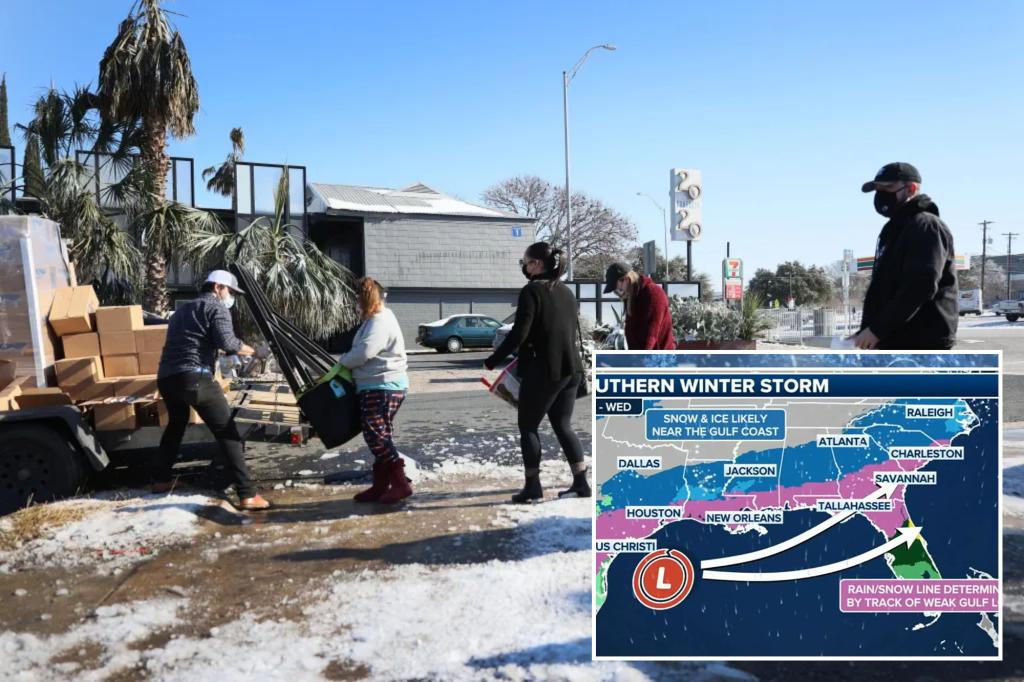A potent winter storm is poised to sweep across the southern United States next week, potentially blanketing parts of Texas, Louisiana, Florida, and Georgia with snow, sleet, and freezing rain. While the arrival of frigid arctic air is a certainty, the precise trajectory and intensity of the precipitation remain uncertain, making the forecast a complex puzzle with significant implications for millions of residents. The intricate interplay of cold air, moisture, and the storm’s path will ultimately determine the extent and severity of the winter weather event.
The first critical element, the arctic air mass, is already on its way, promising a dramatic temperature plunge across the South. Cities like Houston, expecting highs in the 60s on Saturday, will experience a rapid descent into the 20s by Monday morning. This sudden shift to sub-freezing temperatures sets the stage for potential winter precipitation. The arrival of moisture, the second crucial piece, is expected to begin on Monday, spreading across southern Texas. By early Tuesday, this moisture will likely interact with the frigid air, resulting in a swathe of wintry precipitation stretching from Del Rio to Houston.
As the storm progresses eastward, the potential for significant winter weather impacts expands. By Tuesday night, the wintry mix is projected to reach New Orleans and Pensacola, bringing the threat of snow, sleet, and freezing rain. Further east, northern Florida and Georgia are bracing for the possibility of a crippling ice storm, while accumulating snow could extend as far north as Virginia. The storm is anticipated to exit the region by Wednesday afternoon, leaving behind a trail of winter’s signature elements.
However, a significant degree of uncertainty still clouds the forecast. The precise location of the storm and its timing relative to the coldest air are critical factors that remain elusive. Any deviation in the storm’s track could significantly alter the outcome, shifting the zones of snow, sleet, and freezing rain. This inherent unpredictability underscores the challenges of forecasting winter weather in the South, where slight variations in atmospheric conditions can dramatically impact the type and amount of precipitation. Residents are urged to monitor forecasts closely as the storm evolves and prepare for a range of possible scenarios.
The looming threat of winter weather has understandably triggered anxieties in Texas, particularly in light of the devastating 2021 winter storm that crippled the state’s power grid and tragically claimed over 200 lives. The memories of prolonged blackouts and widespread suffering are still fresh, prompting proactive measures to mitigate potential disruptions this time around. The Electric Reliability Council of Texas (ERCOT), responsible for managing the state’s power grid, has issued a Weather Watch from January 20-23 in anticipation of increased electricity demand and potential strain on the system. While ERCOT currently projects normal grid conditions, the situation warrants close monitoring.
Major energy providers in Texas are also taking proactive steps to prepare for the impending winter weather. CenterPoint Energy, serving the Houston metropolitan area, has activated its cold-weather readiness plan, while Oncor, responsible for the Dallas area, has affirmed its preparedness for potential outages. These measures reflect a heightened awareness of the vulnerabilities exposed by the 2021 storm and a commitment to ensuring greater resilience in the face of extreme cold. Furthermore, Houston officials have announced the opening of warming centers on Sunday evening, providing a critical resource for vulnerable populations seeking refuge from the frigid temperatures. These combined efforts represent a significant stride towards mitigating the potential impact of the impending winter storm and safeguarding the well-being of Texas residents.
The impending winter storm serves as a stark reminder of the unpredictable nature of weather and the importance of preparedness. As the storm progresses, residents across the impacted region are encouraged to stay informed about the latest forecast updates, heed the advice of local authorities, and take necessary precautions to safeguard their safety and well-being. The combination of extreme cold, potential power outages, and hazardous travel conditions underscores the need for vigilance and proactive planning. By staying informed and prepared, communities can navigate the challenges of this winter storm and minimize its potential impact.

